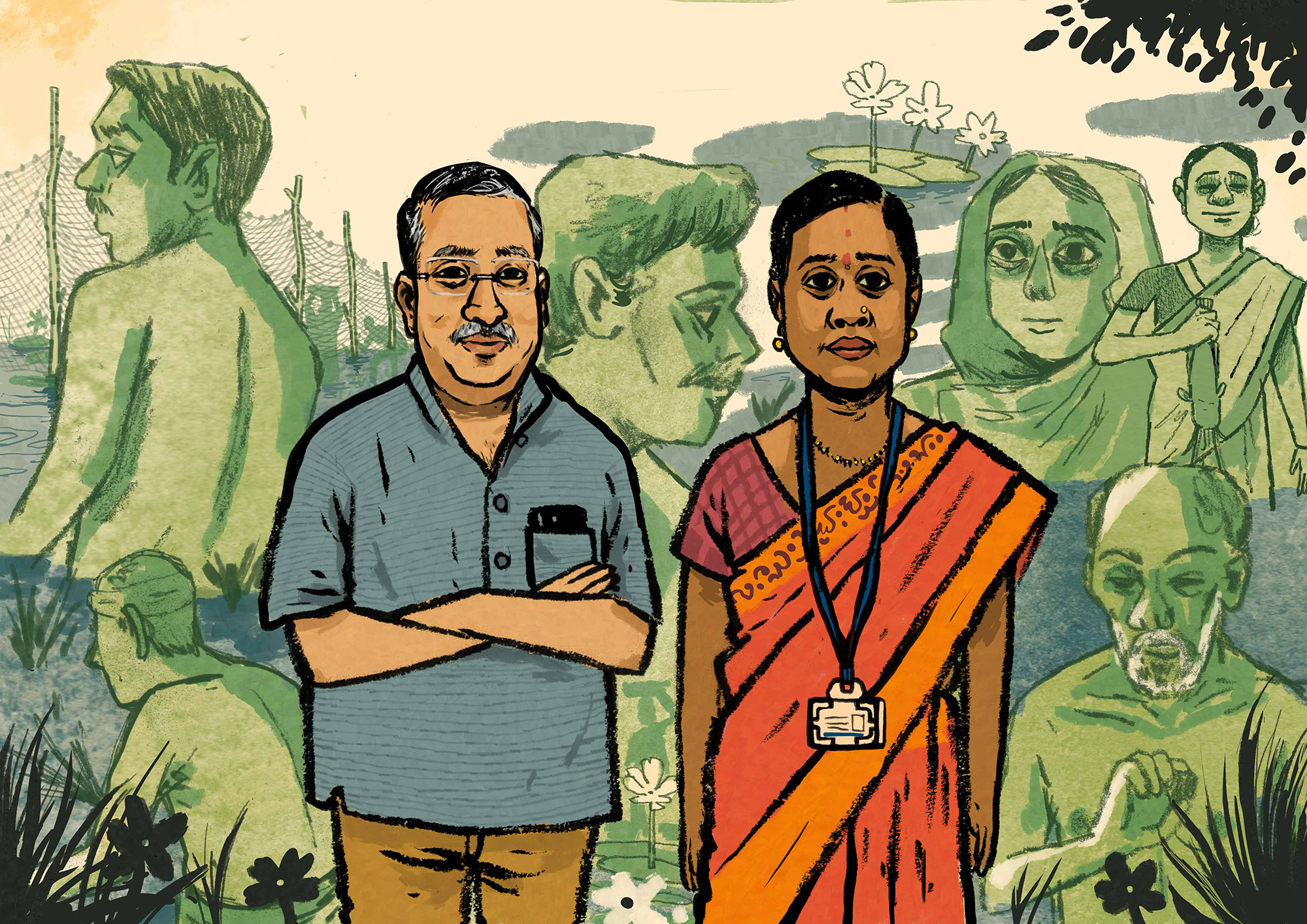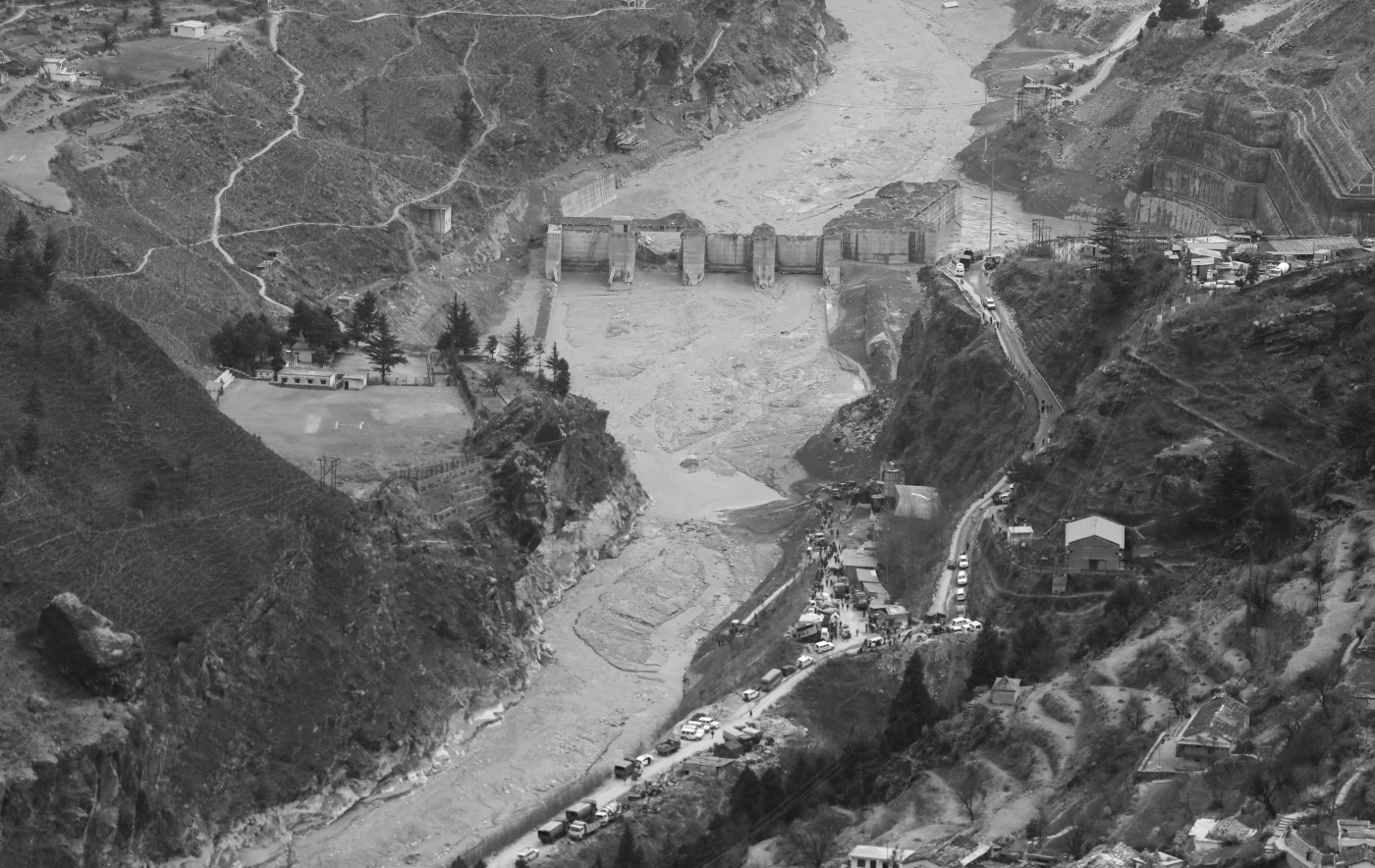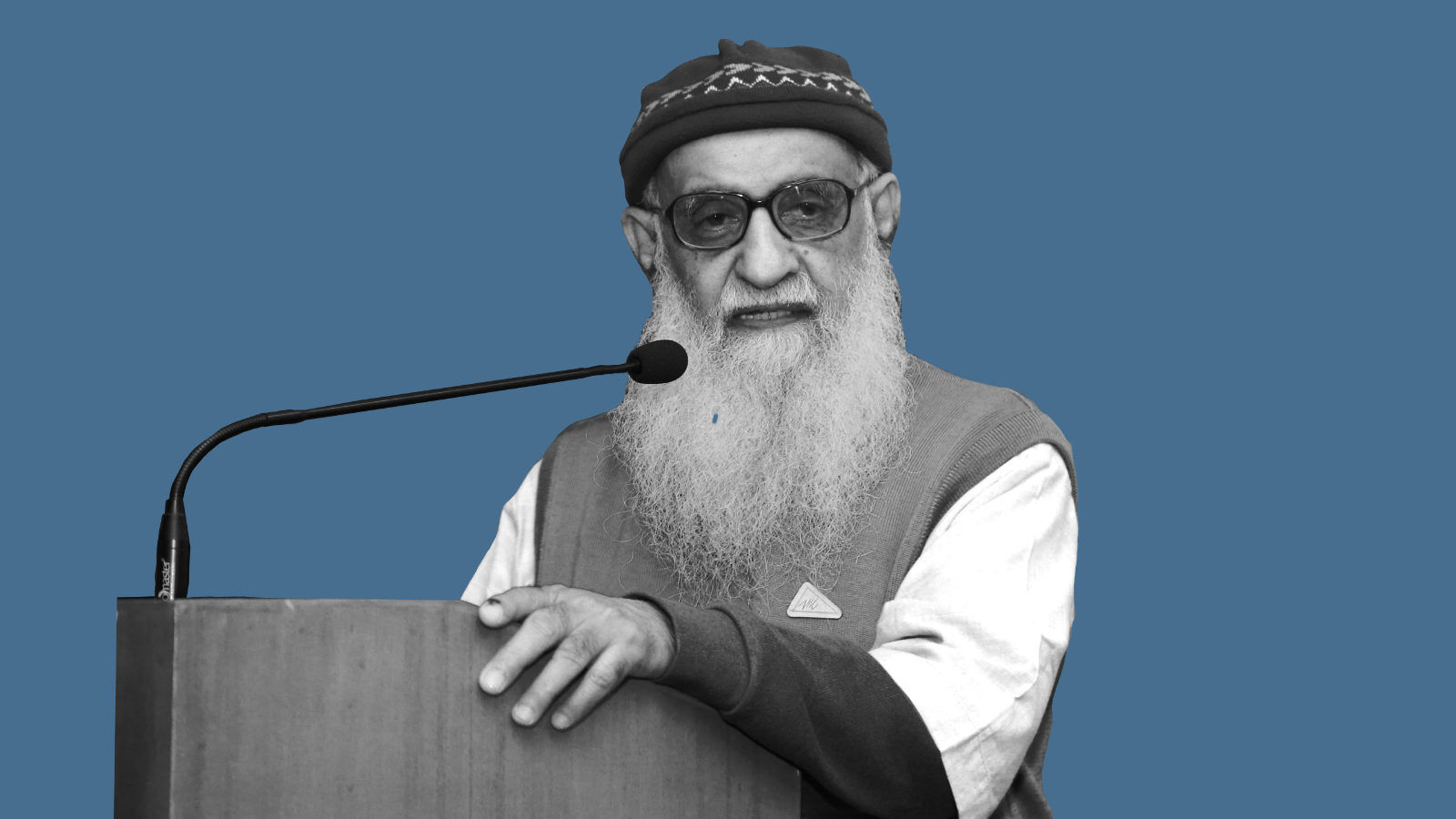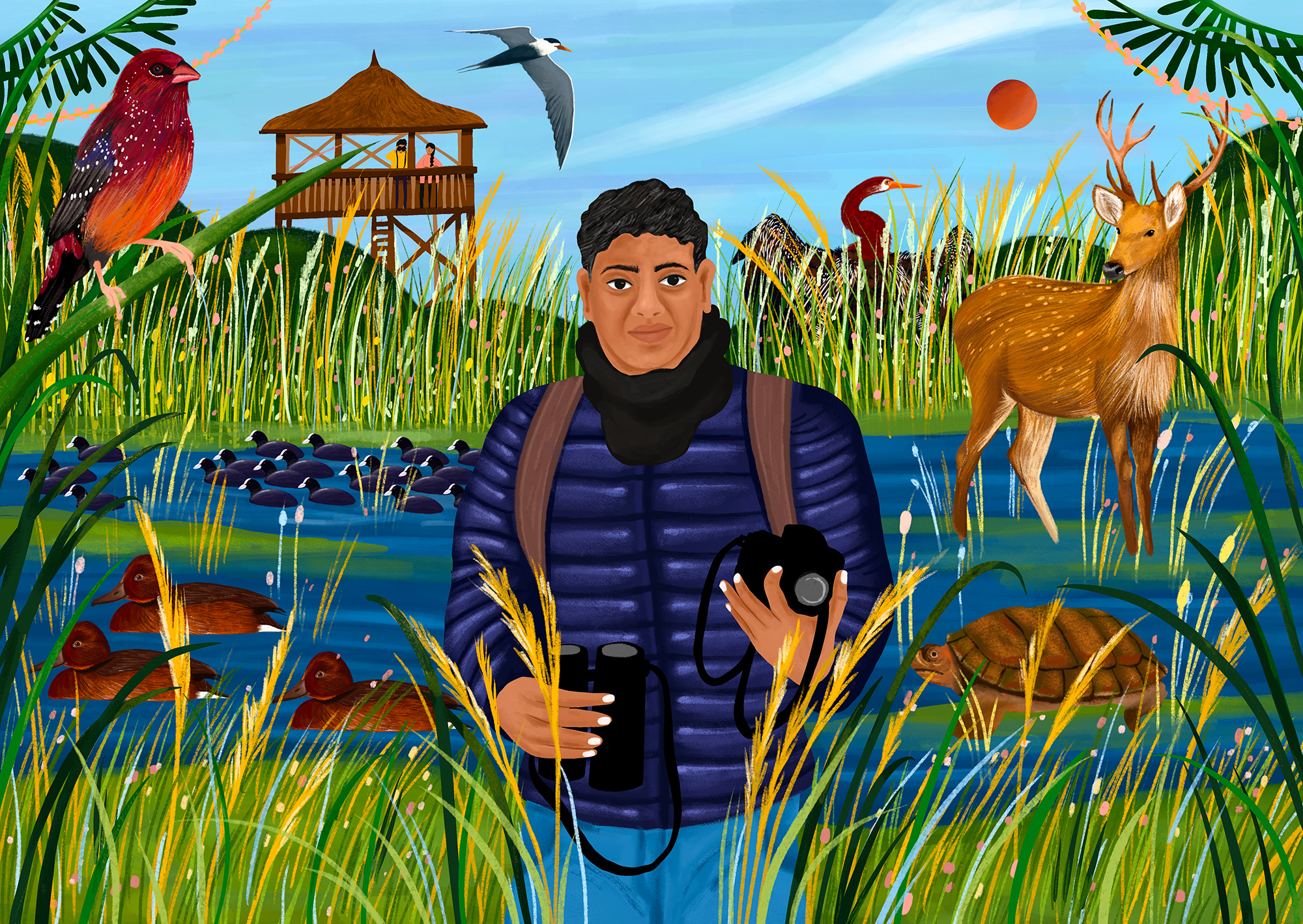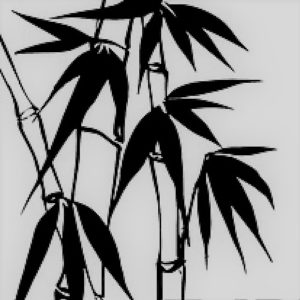- The 300-year-old lakes of Bhandara face two prominent problems among others: proliferation of invasive species of fish leading to decrease in local species and habitat destruction.
- A bird-enthusiast turned development worker, an older Dheevar (fisherfolk community) and a gutsy young woman from the same community have fallen back on traditional wisdom and encouraged local participation to safeguard their livelihood.
- The triumvirate of Malgujari lake conservation in eastern Vidarbha has not just rejuvenated over five dozen lakes and water bodies in Bhandara and Gondia districts but have also given a new hope to the local community, especially the women, of a dignified life.
During his college days, Manish Rajankar was an avid birder. Ably guided by one of his professors, he further developed an interest in conservation and his home ground proved a perfect foil. The then undivided district of Bhandara, on the eastern border of Maharashtra, was known as the ‘Lake District of India’ owing to large number of traditional tanks – ancient lakes and water bodies, majority of which are now around three centuries old.
There were approximately 15,000 of these tanks, locally called MaMa Talao, a short form for “Maaji Malgujari Talao” in Marathi, meaning, lakes from the former malgujari system (akin to zamindari, wherein the revenue came from the lake). The MaMa Talaos, were extensively used for irrigation and fishing.
Extensive paddy plantations; lush green forests, including a National Park and a Wildlife Sanctuary; thousands of lakes (locally also known as tanks), big and small; hundreds of migratory and local birds, especially around Navegaon Bandh, the biggest lake in the area (over 500 ha); a major river, Wainganga and scores of its tributaries; and yet a perceived backwardness – that was Bhandara district then. Bifurcated into Bhandara and Gondia few years ago, both the districts, located in the Vidarbha region of the state, are no exception to the general apathy towards waterbodies across India.

About 25 years ago, regular travels from his hometown of Bhandara to remote areas of the district increased Rajankar’s yearning to ‘do something’, prompting him to explore the development sector. That was when one of his mentors suggested living with the community to learn from them. In early 2000s, Rajankar packed his bags, landed at Arjuni Morgaon, deep inside Gondia district, a place that had bare minimum facilities, uncertain power supply and nothing that was quick and urbane. For almost a year and a half, he spent all his waking hours following Patiram Tumsare, a member of the dheevar (fisherfolk) community from a nearby village Jamhali.
“That was the best hands-on training. I watched Patiram bhau (brother in Marathi) fish, prepare the nets, speak with his fellow fisherfolks, carry out work in the lake, negotiate with traders, work on the lake. Everything. That gave me huge insights,” Rajankar told Mongabay-India.
Slowly, Rajankar developed a clear focus: encouraging local leadership to ensure that the communities that are waterbody-dependent get a decent livelihood along with conservation of the three-century old tank systems in the two districts of Bhandara and Gondia.

From what his mentors had taught him, and from what he observed and absorbed while interacting with the local communities, he was sure that the local talaos can be rejuvenated with traditional wisdom of the Dheevar community, a local fishing community. And a major break from the tradition that he witnessed was gender parity in decision making – women from the community took a lead in the tank management and other things that affected their life by participating in the Gram Sabhas (village councils).
In 1996, Rajankar joined the non-profit Bhandara Nisarga Va Sanskruti Abhyas Mandal (BNVSAM), which had been started in 1993 by environmental enthusiasts of Bhandara. Tumsare and some others also joined the organisation around 15 years ago.
Later, Rajankar also became the Principal Investigator for a project on Freshwater Biodiversity Conservation under the Maharashtra Gene Bank Programme, a project by the Rajiv Gandhi Science and Technology Commission (RGSTC) of the Government of Maharashtra.

Lack of community investment
Bhandara and Gondia districts, like other districts of Maharashtra, have a number of fisher’s cooperative societies. The ownership of the lakes, though rests with different government departments, away from the community investment. This was one of the reasons why many of the lakes were in a dismal state. The government had failed to even mark the catchments properly. Without community involvement, the prized wetlands were neglected, leading to erosion of biodiversity.
Further aggravating this was the government’s decision to introduce invasive, alien species of fish into existing ponds and lakes. The ultimate sufferers were the traditional communities, primarily the fisherfolk, that depended on the water body.
The only positive outcome was that the rights of irrigation were secured through the provision of Nistar rights, under the Maharashtra Land Revenue Code where the fish farmers got free water for irrigation.
After the Centre issued Wetlands (Conservation and Management) Rules, 2010, the government did come up with a database for Bhandara district with listing of wetlands briefs in part I and part II. But none of the lakes figure in the list of Ministry of Environment, Forests and Climate Change for wetland conservation programme launched in 2019. Manju Pandey, joint secretary, MoEF&CC, said, “It is for the state governments to identify the sites.”
Incidentally, Vidarbha Development Board, Nagpur did prepare a comprehensive report, Action Plan for Development of Fisheries and Aquaculture in Vidarbha, but it does not mention anything about conservation of wetlands, fishing water bodies etc.
Habitat revival for lakes
The proliferation of invasive species posed to be a problem for the lakes of Bhandara.
One was the problematic invasive, exotic plant species, Ipomoea fistulosa, called besharam (shameless) in Marathi because of its nature of occupying the entire space on the periphery of the water body. This is the area where plant species from the local ecosystem that are important for aquatic life forms and as fodder for livestock, grew. The invasive plant, growing at a much faster rate and occupying a larger area, drew away all nutrition. And without human intervention to stop its growth, it flourished.
The other ‘invasion’ was by exotic species tilapia, gariepinus and plant feeder grass carp. These either feed on underwater vegetation and/or do not allow smaller fish to grow. Earlier, a government scheme had introduced Indian major carps (IMC), which are the high yield fish species of rohu, catla and mrigal. The three exotic species were introduced in a similar government scheme. Garipinus and pangasius are exotic catfishes that are harmful to indigenous fishes.
Introduced more than three decades ago, IMC production went up substantially and that of local species went down. IMCs are bigger and earlier fetched a lot more money than indigenous fish. But the IMC yield was substantial only once in a year while local breeds could be fished almost round the year.
Also, the fishers realised that while catching these big fishes, they needed to use dragnet, a type of fishing net, which landed up destroying aquatic plants. That in turn affected the production adversely and destroyed the tank further. Additionally, these fishes also ate useful aquatic plants/shrubs.


Each of the fishermen of the cooperative society used four-to-five tanks, of which, one was reserved for biodiversity conservation. “It was then that we had a discussion with Manish bhau. He asked us if anything could be done for aquatic plants? Yes, of course. Just as we plant trees on land, we can do so in water too,” said Tumsare, who was equipped with the traditional knowledge.

Eleven tanks – one from each cooperative society and reserved for biodiversity conservation – were selected for habitat development. Just ahead of monsoon, the lake bed was ploughed. After initial showers, when the lake bed was completely immersed in water, they sowed local species of aquatic plants such as chila, chiul, faandh, chaura, halduli, rajuli, singiful and white lotus (all shrubs). After these was a layer of a variety of traditional grasses and tall shrubs – Submerged plants such as Hydrilla verticilata, Ceratophyllum demersum, Vallisneria spiralis, floating plants like Nymphoides indicum, Nymphoides hydrophylla, Nymphaea cristata and partly submerged plant like Eliocharis dulcis (not in that order).
They decided to reserve that tank only for local fishes such as daadak, vaghur, marad, mothari, savada, shingur, katva etc. The traditional community skills worked wonders; indigenous fish production meant increased income as it fetched more value. “That, in turn, meant, increase in net profit for the cooperative society members from 200% to 700% as the fishermen did not have to invest in stocking and feeding as they did for IMC,” Rajankar explained.
Soon the positive results prompted the fisherfolk to carry out a similar exercise for other tanks.

Women leadership from among dheevar community
All this while, Rajankar felt a gap when he interacted with various community members – the women of the community were almost non-existent. “I just had to do something. How can a community benefit if the women are not involved?” he said.
Fortunately for him, he met Shalu Kolhe, the daughter-in-law of the secretary of one of the fishermen cooperative societies at Nimgaon in Gondia district. The smart, young lady caught his eye and he encouraged her to attend a leadership training programme at Mumbai’s Committee for Resources Organisation (CORO). After getting married in 2008, Kolhe, who had completed her Class 12 education, had spent her time just like any other Dheevar daughter-in-law of the village. Up to 2014, when Rajankar first met her, she had never stepped out of the village on her own, always kept busy with household work and farming and didn’t even know where the village gram panchayat was. The Dheevar women worked in their own farmland or as labourers at other upper caste farm owners, especially Kohlis, the community known as “lake builders”. No one had a say in the matters of their family, let alone something to do with the village.
“Today, when I look back, the journey looks incredible. After much resistance from my home, I decided to attend the CORO training. Only my husband supported me. It was staggered over four installments and for the first two sessions, I was almost blank. But then things came on track and by the time I was through with the training, I was a changed person,” a bubbly Kolhe proudly states about her achievements.

It took a lot of time convincing other women, almost fighting the patriarchy in the village, ensuring the women’s rights are not toppled at the gram sabha, getting their share of work under MNREGA for 15-20 days a month at least under the funds reserved for women. But none of these challenges deterred Kolhe, who also went on to form self-help-groups of fisherwomen. Kolhe has also ensured that she is not the lone woman in this process. Helping other women, bringing them to the forefront too has been an ongoing activity for her.
Convinced that the conservation work can be rightly understood by students at a young age, she took out a rally of school children for ‘Save Biodiversity’. Her popularity grew and so did her acceptance when, slowly, the men from her own and other communities realised that her work benefited the society at large.
The Government of Maharashtra had by then introduced Jal Yukt Shivar and Gaal Yukt Shivar schemes for digging farm ponds and de-silting lakes and water bodies. Extraction of the Ipomoea fistulosa, was decided to be taken up and the activity was carried jointly by the women SHGs, fishing cooperative members and the biodiversity management committee members. In 2015-16, five lakes were identified to remove besharam. The work could have been done under MNREGA using JCB machines but that would damage the lakebed further, so Kolhe decided to go ahead with shramdaan (voluntary physical work) to remove the besharam shrubs manually, let them dry and remove the root too.
Rajankar informed that the five tanks were monitored for two years; post monsoon study was carried out on four sites for which other species grew when besharam was absent and how it affected the growth of fishes. Yield has increased at all those sites now.
Over the years, BNVSAM’s work has gained popularity. As of the end of 2019, they work with 12 fishing cooperatives with 63 lakes across 43 villages.

(This story was first published by Mongabay India on December 16, 2020. It can be read here.)
